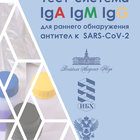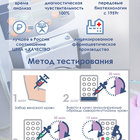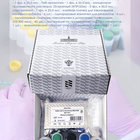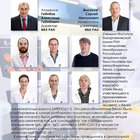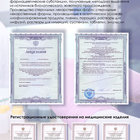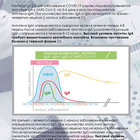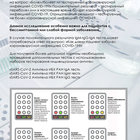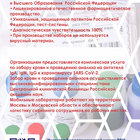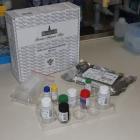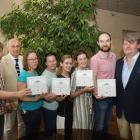History of Institute of bioorganic chemistry
The Institute was founded on February 20, 1959 with decision of Presidium of AS USSR and named as The Institute of natural compounds chemistry (INCC). New institute was situated in Moscow, on Vavilov street, 32 (ex-building of the Institute of mining AS USSR). M.M. Shemyakin became its first director.
Thats how started researches in chemistry of biopolymers (proteins and peptides, nucleic acids, carbohydrates, lipids, mixed polymers, etc.) and different natural and synthetic regulators of biological processes (antibiotics, vitamins, hormones, ferments) in Russia. In 60-s in INCC under M.M. Shemyakin and M.N. Kolosov leadership there were made numerous chemical researches on the most important antibiotics chloramphenicol, tetracyclines, antibiotics of aurelic acids group and so on. At the same time research of more complex proteins started, that made base for development of new science bioorganic chemistry. Exactly works of academician M.M. Shemyakin and scientists of INCC made chemistry of proteins and peptides being rapidly developed in our country. Also a novel method for determination of peptides and proteins amino-acid sequence by mass-spectrometry was developed and a new method of peptides synthesis on a polymer carrier was proposed (M.M. Shemyakin, Yu.A. Ovchinnikov, A.A. Kiryushkin, E.I. Vinogradova, A.I. Miroshnikov, Yu.B. Alakhov, V.M. Lipkin, Yu.B. Shvetsov, N.S. Wulfson, B.V. Rosinov, V.N. Bochkarev, V.M. Burikov (1966). Mass spectrometric determination of the amino-acid sequence of peptides. Nature 211 (5047), 361366). Abilities of these methods were demonstrated with synthesis of series of natural peptides (gramicidin S, angiotensin, etc.) and their analogs; later such a method was used by other researchers for synthesis of oligonucleotides. Works of M.M. Shemyakin and his colleagues devoted to problems of antibiotics research, especially monograph Chemistry of antibiotics published in 1949, 1953 and 1961, had great impact on development of antibiotics chemistry.
A number of very interesting works (19651975) must be marked out: they were devoted to a complex biological research of peptides containing residues of both amino acids and oxyacids depsipeptides (this name was offered by M.M. Shemyakin and colleagues). Based on the developed in the Institute general scheme of synthesis of optically active depsipeptides, huge amount of different natural cyclodepsipeptides and their analogs were synthesized. Numerous researches permitted to ascertain, approve or disapprove structures of these natural compounds, which were offered before that.
Later, with different physicochemical methods such as NMR spectroscopy, which during that time was rapidly gaining importance, researches of spatial structure of depsipeptide antibiotics were conducted. Very important property was revealed: formation of steady complex with ions of alkaline metals and their transfer across the membrane of bacterial cell. Indeed, these works became the very first performed in molecular basics of different matters transportation through biological membranes. Later it became clear: analogous results were almost made in different foreign laboratories, but soviet scientists of the Institute finished first. Results of this series of works were presented on different international conferences and after that they were summarized in reviews and monographs (for example, Membrane-active complexons, for which Yu.A. Ovchinnikov and V.T. Ivanov were rewarded in 1978 with Leninskaya award). Nowadays in front of the IBCh RAS sculpture of valinomycin in complex with potassium ion reminds us about fundamental meaning of depsipeptides.
In Riga in 1970, with academician M.M. Shemyakin and his colleagues hands on was conducted the 7th International symposium on chemistry of natural compounds (IUPAC), in its work world leaders of science were taking parts. For that time it became the largest conference in USSR, devoted to chemistry. But during this symposium M.M. Shemyakin suddenly passed away.
After his death Yu.A. Ovchinnikov Shemyakins student, young and active academician, became the leader of INCC. Due to his organization talent and sense of science, 70-s and80-s became breakthrough not only in national, but international physicochemical biology and biotechnology. Then the Institute was renamed in more modern way: the M.M. Shemyakin Institute of bioorganic chemistry.
In 1970-s middle 1980-s in the Institute there were decoded primary structure of such important proteins as aspartate aminotransferase (the key enzyme of mammals nitrogen metabolism) and leucine-binding protein, different neurotoxins from snakes and spiders venoms, huge membrane chromoproteins bacteriorhodopsin from halophilic bacteria and visual rhodopsin from bovine retina (1981) and completely finished structural analysis of the largest (for those days) known protein DNA-dependent RNA-polymerase. Determination of amino-acid sequence of bacteriorhodopsin has been continuing in severe competition between the Institute and the Labaratory of Nobelist G. Khorana (USA), and priority was on our side. This work became the first decoding of chemical structure of the membrane protein.
A lot of the Institutes employees activities has been rewarded with national awards and orders, and in 1981, with decision of the Presidium of the Supreme Soviet USSR, IBCh AS USSR was rewarded with order of a Labour red banner.
On the directors Yu.A. Ovchinnikov initiative, education of new manpower for physicochemical biology and biotechnology was actively developing: there were created new subdepartmants in MSU, MIPT, MIFCT (nowadays MSAFCT) and in some else. In 1982 on the base of these subdepartments in IBCh was founded specialized Educational and scientific center. For some last years of his life academician Yu.A. Ovchinnikov, in spite of a grave illness, has been hard working on fundamental textbook Bioorganic chemistry published in 1987. At the same year passed first (it became annual later) winter scientific school for young scientists, students and postgraduates in perspective areas of physicochemical biology and biotechnology.
In 1984 the Institute moved to a new place occasion, to a new building with perfectly equipped laboratories. At the same year in Moscow very important scientific event happened: 16th Conference of Federation of European biochemical societies (FEBS).
In 1979 with decision of the Presidium AS USSR in Pushchino (Moscow Region) there was founded the Branch of the IBCh AS USSR, and in 1988 building of new complex for this branch was finished, as well as the building of the station of artificial climate Biotron for large-scale tests on plants and laboratory of biological tests (Biocenter) for preclinical trials of the newest medicines.
In the making of bioorganic chemistry and physicochemical biology there were made all prerequisites for development of biotechnological industry development of the newest effective medicines and crops. As culmination we may call creation in 1985 intersectorial scientific and technique complex BIOGEN (Yu.A. Ovchinnikov became a director), which comprised several scientific institutes and plant facilities which worked for national biotechnological production. They produced interferon α and γ, immunomodulators Likopid, Neoteam-NC, Seramil and so on. From 2003 on the base of the Institute they produce Russian recombinant human insulin Insuran.
In 1988 Yu.A. Ovchinnikov has passed away. His heir as a new director of the Institute became academician V.T. Ivanov. 90-s were hard time for a whole country and for national science. But in spite of all obstacles, research in different areas of physicochemical biology and biotechnology has been continuing: an absolutely new subject emerged research of proteins fluorescence and creation and development of fluorescent tools for for different biomedical tasks. In collaboration with leading Institutes of Europe and USA there were made researches of transgenic plants, search for new methods of improving economic valuable properties of plants, started biological tests on new medicines that have been produced in the Institute.
In 1992 the Institute was renamed in the memory of Yu.A. Ovchinnikov, there have been started regular readings devoted to him. In 2009 there has passed international conference, devoted to the 75th anniversary of academician Yu.A. Ovchinnikov, gathered in Moscow a lot of world-famous scientists, including Nobelists.
Since 2017 the Institute is headed by Academician Alexander Gabibovich Gabibov. The International Advisory Board has been created at the IBCh RAS. The members of the Board are outstanding scientists from around the world. The structural reorganization is taking place so that the laboratories are combined by similar areas of research within departments. In 2018 on the basis of IBCh RAS the National Technological Initiative Center (NTIC) has been created for the presentation and implementation of biotechnologies developed in the Institute.
In January 2020, the world was gripped by the global SARS coronavirus pandemic. Rapid spread of infection and the severity of the disease raised several important tasks for the international scientific community. First, to develop diagnostic systems for virus detection. The IBCh RAS took an active part in solving this problem. Together with the Russian Academy of Sciences and the Central Clinical Hospital of the RAS, Institute developed a comprehensive test system for the early detection of antibodies to SARS-CoV-2. Another, even more important task was the development of vaccines and drugs that would allow to, if not completely remove the virus from the population, then at least significantly reduce its harmful effects in the form of high mortality rate and various complications. The Institute took an active part in this line of work as well. Firstly, the IBCh RAS, Pharmasyntez group and the international biopharmaceutical company HiFiBio Therapeutics have signed agreements under which the participants combine their competencies to conduct clinical trials, manufacture, and supply to the Russian market the monoclonal antibody HFB30132A for the treatment and prevention of coronavirus infection COVID-19. Secondly, the Ministry of Science and Higher Education, the Ministry of Industry and Trade, as well as the Ministry of Health of the Russian Federation commissioned the Institute carrying out a project for the development of a culture media for growing cell lines producing the «Sputnik V» vaccine, which by the end of 2020 was approved for mass use in Russia, and then in many other countries.
Thus, the high level of professionalism of the staff, the available instrumental equipment, as well as the coordination of departments and well-built mechanisms of work within the Institute, allow the IBCh RAS to successfully carry out scientific activities in the most relevant areas of physical and chemical biology and biotechnology, quickly meet modern challenges of the time and remain a leading institution in Russia and the world.



































































